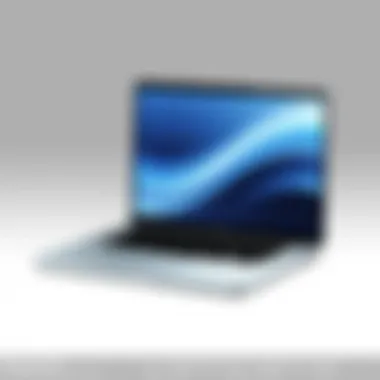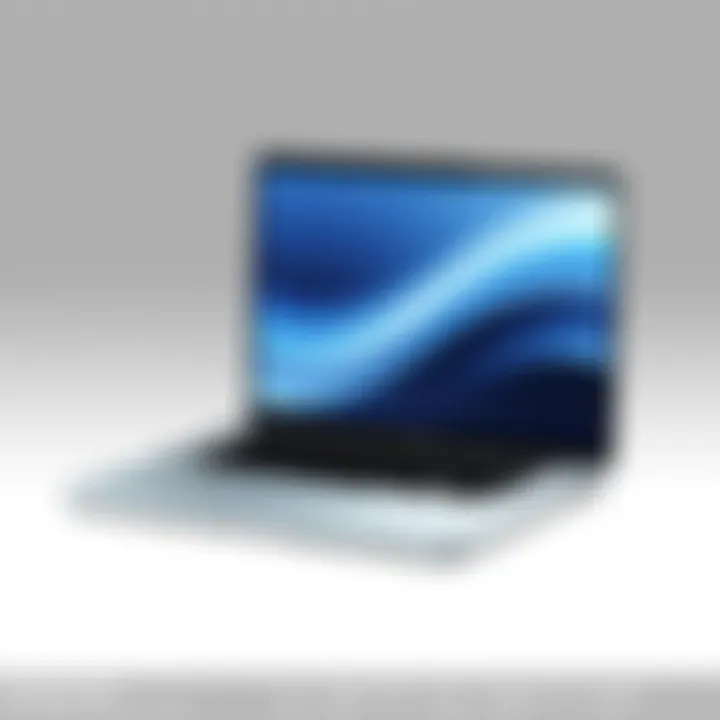MacBook Pro 13 (2015) Review: Performance Insights


Intro
As we step into the domain of technology, where devices become obsolete almost as quickly as they are released, the 2015 MacBook Pro 13 stands out like a seasoned professional in a sea of fresh graduates. Evaluating its performance and usability requires delving not just into its specifications, but also understanding its place in our current tech-centric lifestyle.
While many may question the practicality of a nearly decade-old machine, it's crucial to consider its robust build, performance capabilities, and overall functionality that still resonates with today’s tasks. For IT professionals and tech enthusiasts, assessing whether this MacBook holds its ground amid evolving technological advancements is indeed a pertinent discussion.
This exploration will touch on fundamental aspects ranging from impressive specifications to its design and material quality, leading to an overarching understanding of how well this machine serves its users, and if it remains a viable candidate in today’s gadget-oriented marketplace.
Overview of Product Features
Understanding a product's features is pivotal to gauging its performance and usability. The 2015 MacBook Pro 13 brings with it a set of specifications engineered to cater to both casual users and professionals alike.
Key Specifications
The ground beneath the MacBook Pro's performance is underpinned by its noteworthy specifications:
- Processor: It carries either an Intel Core i5 or i7 CPU, ensuring smooth multitasking and efficiency in handling demanding applications.
- RAM: With options for 8GB or 16GB of RAM, the machine competently handles heavier workflows.
- Storage: Solid state drives (SSD) ranging from 128GB to 1TB ensure rapid data access and system boot-up.
- Display: A stunning Retina display brings visuals to life with vivid colors and sharp details, crucial for designers and content creators.
- Battery Life: Not to be overlooked, the battery life extends up to 10 hours, facilitating prolonged use without the constant hover of a charger.
Unique Technologies
This MacBook isn't just another laptop—it's infused with unique technologies that set it apart:
- Force Touch Trackpad: Designed to provide pressure-sensitive functionality, this trackpad allows for nuanced control—simple taps become enhanced with varied pressure.
- Thunderbolt 2: Enhanced connectivity options cater to professionals needing to link with multiple displays and high-speed storage drives effortlessly.
- iSight Camera: The built-in camera provides reliable video quality for remote meetings and collaborations.
Preamble to the MacBook Pro ()
The MacBook Pro 13 (2015) holds a notable place in the ever-evolving landscape of laptops. Released amidst a flurry of competitive devices, it struck a balance that appealed to both everyday users and tech professionals. As we delved into this review, the importance of understanding its historical significance and usability cannot be understated. For IT professionals and tech enthusiasts, the device exemplifies a blend of design, performance, and reliability that remains relevant even today.
The MacBook Pro has long been viewed as a benchmark in the laptop market. An understanding of its features will help potential buyers grasp the advantages and limitations it presents, especially in a world where rapid advancements in technology often overshadow older models. This analysis will offer insights not only on its specifications but also on its quintessential role within the Apple ecosystem.
In navigating through this article, you’ll find detailed assessments of the Pro’s capabilities in the context of its time and a comparison to what current alternatives provide. Evaluating the 2015 model sheds light on its enduring qualities that still resonate with users today, making it a point of reference for both comparisons and recommendations in various tech discussions.
With this groundwork laid, we will proceed to unpack the historical significance of the laptop along with an exploration of its intended market. These factors will guide the overall understanding of the MacBook Pro 13 (2015) as a product that continues to capture the interest of discerning users.
Design and Build Quality
The design and build quality of a device can drastically influence its overall user experience. For the MacBook Pro 13 (2015), this aspect plays a pivotal role in how the laptop is perceived by users, especially among technology professionals and enthusiasts. A solid design not only enhances aesthetic appeal—making it a visually pleasing gadget—but also ensures the machine can withstand the rigors of daily use.
Aesthetic Elements
When it comes to the MacBook Pro 13 (2015), the visual elements reflect Apple's distinctive design language. The laptop's sleek, aluminum body—often described as minimalist—exudes a sense of sophistication. Its metallic finish, coupled with a symmetrical structure, delivers a modern flair that is hard to overlook. Users might find the ultra-thin bezels around the display particularly enticing, providing a more expansive view for work and pleasure.
The keyboard features a backlight that can be adjusted to different brightness levels, which is particularly useful in low-light environments. This attention to detail enhances usability without sacrificing style. Additionally, the subtle curves of the device frame contribute to a seamless user experience, allowing users to transition smoothly from one task to another.
Materials and Durability
In the realm of materials, the MacBook Pro 13 (2015) employs sturdy aluminum for its chassis. This choice isn't mere happenstance; it serves a dual purpose. Not only does aluminum lend itself to a premium feel, but it also provides strength against everyday wear and tear. Many users have reported their MacBooks enduring minor accidents—drops or spills—without suffering catastrophic damage, showcasing the robust build quality.
Yet, it's not just about toughness; the design also considers heat dissipation. The air vent positioning aids in cooling during intense tasks, which can be crucial during demanding work such as video editing or 3D rendering. This combination of material selection and design intricacies lends assurance to individuals who bet on the long-term usability of their machines.
"A laptop is not just a tool; it becomes an extension of oneself. A well-crafted design resonates with its user in ways that extend beyond mere functionality."
Technical Specifications
When diving into the realm of the MacBook Pro 13 (2015), discussing technical specifications takes center stage. These specifications form the backbone of the device, providing insights into its performance capabilities, usability, and how well it serves its intended audience. Understanding these details can help potential users determine if this MacBook suits their needs in today's tech-driven world.
Hardware Components
Processor Specifications
The processor, often referred to as the brain of the machine, plays a vital role in the MacBook Pro's overall performance. The 2015 model is powered by a dual-core Intel Core i5 processor, with a frequency clocking at 2.7 GHz, as well as an option for a faster i7 variant. This particular choice is notable due to its balance between power consumption and performance.
What sets the processor apart is its Turbo Boost technology. This unique feature allows the processor to dynamically increase its speed during intense tasks, promising a smoother experience, whether the user is rendering video or running complex applications. However, it’s essential to note that while the Turbo Boost can enhance performance, it can also lead to increased heat generation, which may be a concern during long use periods.
Memory and Storage Options
Memory and storage options in the 2015 MacBook Pro are designed to cater to a range of user needs. With 8GB of LPDDR3 RAM as standard, it offers smooth multitasking capabilities. Some versions allow for upgrading to 16GB, making it a judicious pick for professionals who run memory-intensive applications.
Storage comes via flash-based SSD, which not only improves boot times and task loading speeds but also enhances the device's overall responsiveness. Users can opt for configurations ranging from 128GB to a beefy 1TB SSD. While the larger storage options provide ample space for files, creatives or those managing big projects, the 128GB model might have some users scrambling for extra storage solutions down the line.


Graphics Capabilities
Graphics performance can often make or break a device for users focused on creative work. The MacBook Pro 13 (2015) features integrated Intel Iris Graphics 6100, which offers decent performance for tasks such as photo editing and video playback.
The integrated GPU supports up to 1536 MB of shared memory, which is a significant boost for everyday use. A noteworthy aspect of this graphics capability is its energy efficiency; it manages to balance performance while conserving battery life during less demanding tasks, making it advantageous for users who are frequently on the move. However, for high-end gaming or heavy graphical applications, users might find this combination lacking, and it may call for a dedicated graphics card.
Operating System and Software
Pre-installed Software Suite
Out of the box, the MacBook Pro (2015) comes equipped with macOS Yosemite, which introduces a plethora of features enhancing productivity and usability. This operating system was designed with a focus on user interface and ease of use, making it approachable, even for non-tech-savvy individuals.
A tough highlight is the inclusion of useful apps such as Photos, iMovie, and GarageBand. This pre-installed software isn't just fluff; it allows users to kick off their projects immediately after unboxing. However, some may desire more professional-grade software that isn't included, potentially turning to costly third-party options.
System Updates
Staying current is a significant consideration for any IT professional. The MacBook Pro (2015) has the potential to support newer macOS versions, although—exclusively depending on Apple’s continuing support—users might find themselves limited as newer iterations roll out. The unique feature of regular system updates ensures security and performance enhancements, helping prevent software obsolescence over time.
However, as the hardware ages, compatibility could become an issue with the most demanding updates, leading to possible frustration for users who want to push the limits of their device. Overall, keeping the MacBook current will require an understanding of its capacity to manage future software demands.
Performance Analysis
Performance analysis is crucial when evaluating the MacBook Pro 13 (2015). It sheds light on how well the device meets the demands of various tasks, from casual browsing to intensive applications such as video editing or programming. A thoughtful review of performance can guide potential users in understanding whether this model still holds up in a world that constantly demands more and more from technology.
Benchmark Testing
Geekbench Scores
Geekbench scores offer a quick way to gauge how the MacBook Pro 13 compares to its peers and predecessors in terms of raw computing power. The scores it racks up in Geekbench, particularly in single-core and multi-core tests, depict its ability to handle specific tasks efficiently.
A distinct feature of Geekbench is its cross-platform nature; it allows users to compare Apple devices directly with Windows and Linux counterparts. This flexibility makes it a popular option for those wanting a clear performance snapshot. As the 2015 MacBook Pro holds its ground with respectable scores, it portrays the device's overall speed and responsiveness, vital for users seeking reliable performance.
However, there are downsides to consider. While Geekbench provides a general overview, it doesn’t account for real-world application performance. Thus, while a high score may indicate potential, it may not reflect the experience of multitasking or using resource-heavy applications continuously.
Real-world Usage Scenarios
When diving into real-world usage scenarios, we examine how the MacBook Pro performs outside of synthetic tests. Scenarios such as video editing, gaming, and multitasking yield insights that benchmarks might miss. Users often report that the laptop handles most everyday tasks seamlessly—from browsing with multiple tabs open to running software like Adobe Photoshop without a hitch.
The key characteristic here is adaptability; the MacBook Pro responds well to the demands of different applications. What often wins praise in user feedback is its ability to maintain performance under pressure, such as when rendering videos or processing large datasets. Still, it’s essential to note that prolonged usage can test the device's limits, leading to throttling in some CPU-intensive tasks.
Battery Life and Efficiency
Battery life is another cornerstone for potential users to mull over. The MacBook Pro 13 (2015) offers battery capacity that manages to extend usage significantly, often touted by users as one of its strong points.
Battery Capacity
Battery capacity stands at 74.9 watt-hours, which allows for longer usage sessions. This feature gives the device a competitive edge, making it a go-to for professionals on the go. Users involved in graphic design or intensive programming have often highlighted the capability to work unplugged for hours on end. However, external factors like screen brightness and application demands can influence how long the battery truly lasts.
The downside is obvious; heavy users may still find themselves reaching for the charger more frequently than they wish, especially if they push the laptop’s limits.
Average Usage Times
Average usage times provide a more practical view of what to expect in daily tasks. Generally, users have reported about eight to ten hours on a full charge with standard use, which includes video streaming, web browsing, and light productivity tasks. What’s particularly beneficial about this is how the laptop holds its efficiency in less demanding scenarios, giving users the confidence to handle tasks without having to be tethered to a power outlet.
Nevertheless, the battery can drain quicker during high-performance tasks, so avid gamers or video editors might need to keep that charger handy. Overall, its average battery life cements the MacBook Pro 13 as a dependable option in today’s landscape.
"In an age where portability is often at odds with performance, the MacBook Pro 13 (2015) manages to strike a balance that appeals to a diverse range of users."
Through this deep dive into performance, it’s clear that while numbers matter, the real-world applicability showcases just how well the MacBook Pro 13 has held its own, regardless of the passage of time.
Usability and User Experience
Understanding usability and user experience is fundamental when evaluating any computing device, including the MacBook Pro 13 from 2015. The term usability encompasses how easy and intuitive it is for users to interact with a device, while user experience digs deeper, looking at how enjoyable and satisfying that interaction is over time.
For IT professionals and tech enthusiasts, these factors aren't just about preference; they're about efficiency and productivity. A device with good usability can minimize the learning curve and enable users to focus on their tasks rather than on how to operate the hardware. This fosters a seamless workflow, ultimately leading to greater satisfaction with the product.
Keyboard and Trackpad Assessment
The keyboard and trackpad on the MacBook Pro 13 (2015) are often lauded for their performance and user-friendly design. The keyboard features a scissor mechanism, which provides more stability compared to traditional designs. Users typically appreciate the tactile feedback, allowing for comfortable typing—whether it's for the quick drafting of emails or extensive coding sessions.
Moreover, the trackpad stands out for its size and responsiveness. Featuring gesture capabilities, it allows users to swipe, pinch, and zoom with relative ease, facilitating navigation while multitasking. The inclusion of Force Touch technology enables additional functionality, responding dynamically to varying pressure levels. This kind of innovation aligns with the needs of professionals who juggle various tasks throughout their day.


Display Quality
A device's display can make or break the user experience. With the MacBook Pro 13 (2015), the Retina display assures crisp visuals, which are crucial for everything from graphic design to video editing.
Resolution and Color Accuracy
One of the significant characteristics of the Retina display is its high resolution of 2560 x 1600 pixels. This clarity translates into vivid colors and sharp text, making it an attractive choice for professionals who need precision in their work. Color accuracy is particularly vital for designers and photographers, as it ensures that what they see matches the output. The display covers a wide color gamut, making images look more lifelike and stunning.
In terms of benefits, this sharp resolution contributes to reduced eye strain, especially during prolonged use. Users working with detailed graphics can examine their work without squinting or misinterpreting colors. However, the display can have a slight disadvantage; when viewing in direct sunlight or bright environments, reflections may pose a challenge, somewhat diminishing its usability in outdoor settings.
Viewing Angles
The viewing angles on this model are another commendable aspect. The IPS technology allows the screen to maintain color fidelity and contrast even at sharp angles. This characteristic is significant for collaborative work, where sharing the screen with colleagues is a common practice. Whether you're pitching ideas during meetings or showing off designs, the ability to see an accurate representation of the screen from various perspectives is an essential benefit.
However, the downside comes with the reflective nature of the screen. While the angles are impressive, in very bright environments, the reflection may hinder visibility. This is something users traveling or working in varied lighting should consider.
"A computer is only as good as its ability to connect with its user through thoughtful design, both in its function and aesthetics."
In summarizing the usability and user experience of the MacBook Pro 13 (2015), it becomes clear that, while no device is without flaws, its keyboard, trackpad, and display form a harmonious foundation that meets the demands of today's professionals. The combination of thoughtful design elements ensures that the device is not just a tool but also an extension of the user's needs.
Connectivity and Compatibility
When considering the MacBook Pro 13 (2015), connectivity and compatibility are pivotal aspects that significantly impact its usability. In an age where seamless integration between devices defines the user experience, these features aren't merely nice to have—they're essential for maximizing productivity and ensuring that the device can be utilized effectively in various contexts. From professional settings to personal use, knowing how well this model connects with other devices, software, and peripherals helps potential users make informed choices.
Ports and Connectivity Options
USB and Thunderbolt Ports
The MacBook Pro 13 (2015) is equipped with two USB 3.0 ports and two Thunderbolt 2 ports. Each of these ports plays a crucial role in enhancing the device's connectivity landscape. The speed of USB 3.0 can reach up to 5 Gbps, making file transfers and peripheral connectivity fairly quick. On the other hand, Thunderbolt 2 offers even greater performance, supporting data transfer rates of up to 20 Gbps and enabling multiple devices to connect through a single port. This feature becomes exceptionally beneficial when daisy-chaining devices like high-resolution monitors or external storage arrays that demand higher bandwidth.
A unique aspect of the Thunderbolt 2 ports is their versatility; they can be utilized for video output besides traditional data transfer. This means connecting it to a 4K display, or using it with high-speed devices is remarkably straightforward. However, it's worth noting that while Thunderbolt is advantageous for professional workflows that require speed and efficiency, it can come with a higher cost for compatible peripherals.
Wireless Capabilities
Wireless connectivity in the MacBook Pro 13 (2015) is anchored by its robust 802.11ac Wi-Fi support, which is a significant leap over previous versions. This enables quicker connections—ideal for downloading large files, seamless video streaming, and reliable online collaboration. With Bluetooth 4.0 support also included, users can easily connect various devices like wireless headphones, external keyboards, or mice, with minimal hassle.
However, the performance of wireless capabilities can be influenced by various factors, such as the distance from the router and surrounding obstacles. While 802.11ac offers better range and speed compared to its predecessors, users in larger spaces might find the connection quality varies. Hence, understanding one's network environment can either amplify or inhibit the seamless experience expected from wireless capabilities.
Compatibility with Software Ecosystem
Pairing with iOS Devices
The ability to pair the MacBook Pro 13 (2015) with iOS devices like iPhones and iPads significantly contributes to its ecosystem compatibility. This integration allows for features like AirDrop for easy file sharing, Handoff for starting tasks on one device and continuing on another, and iCloud synchronization to keep files updated across devices. This functionality is especially appealing for users who are already embedded in Apple's ecosystem. However, a catch lies in the requirement for all devices to have updated software to take full advantage of these features.
Cross-platform Software Performance
In terms of software performance, the MacBook Pro 13 (2015) performs admirably across various platforms. Whether using Adobe’s suite or Microsoft Office, users find that the hardware capabilities align well with the demands of both casual and intensive tasks. A defining characteristic here is that the macOS operating system itself works smoothly with most applications designed for it, ensuring reliable performance. Yet, when it comes to running Windows applications via Boot Camp or virtualization software, there could be some limitations on graphic-intensive programs. Users should be cognizant of their specific software needs before making decisions related to cross-platform compatibility.
Key Takeaway: The Connectvity and Compatibility of the MacBook Pro 13 (2015) create a robust environment for users looking to leverage multiple devices and applications within their tech ecosystem, although certain nuances must be considered to optimize the experience.
Comparative Analysis
Comparative analysis holds a significant place in evaluating the MacBook Pro 13 (2015) because it extends beyond just examining this one model. By juxtaposing it with peer devices, potential buyers can get a clearer understanding of its strengths or weaknesses. This section provides insight into both its positioning against competitors and how it stacks up against its own lineage, reflecting the evolution in technology.
Comparison with Competing Models
MacBook Air vs. MacBook Pro ()
When comparing the MacBook Air with MacBook Pro 13 (2015), the discussion often revolves around performance versus portability. The MacBook Air, known for its lightweight and slim profile, weighs less than its Pro counterpart, making it a favorite among users who prioritize mobility. It sports a longer battery life, which is complemented by an efficient architecture that favors casual users or students who work primarily on lighter tasks like web browsing, document creation, or media consumption.
On the other hand, the MacBook Pro 13 (2015) enters the ring beefed up with superior specs, particularly in areas like processing power and graphics capabilities, making it a solid choice for more demanding tasks. An exclusive feature of the Pro model is the optional Retina display, which offers remarkable clarity and color precision, ideal for graphic designers, video editors, and anyone who needs that extra punch in display quality. In contrast, the Air's older display tech may feel less vibrant for those in creative fields who swirl with colors on the screen. The Pro also has a dedicated cooling system which enables sustained performance during intensive tasks. This makes the Pro a beneficial option for users needing more multi-tasking ability without slowing down.
PC Alternatives Reviewed
In the sea of options, PC alternatives draw a lot of interest, especially models that have made their mark in performance and value. Brands like Dell and Lenovo have champions that compete well with the MacBook Pro 13. The Dell XPS 13, for instance, features a sleek design paired with powerful Intel processors that can easily match or sometimes exceed the performance of the Mac's internals.
On the other hand, Lenovo ThinkPad X1 Carbon is known for its robust build quality and exceptional keyboard comfort, beneficial for professionals who spend long hours typing. Its array of ports slightly edges over the MacBook Pro's offerings but lacks the polished software ecosystem that MacOS provides. Each alternative has its unique features, such as superior adjustability or customizable hardware, presenting both advantages and pitfalls depending on user preferences. While PCs often sport a wider range of configurations at different price points, they sometimes compromise on build quality and software integration that seasoned Mac users cherish.
Legacy vs. Current Models


Technological Evolutions
The leap from the MacBook Pro 13 (2015) to current models showcases fascinating technological evolutions. More recent models feature advancements in processors, with Apple now transitioning to its own silicon, which has proven to enhance performance and battery life significantly. The speed and efficiency of Apple’s M1 and M2 chips have reset the bar for performance standards in laptops, leading many power users to consider whether holding onto an older MacBook Pro is worth the trade-off in newer capabilities.
What stands out in the narrative of technological evolution is also the gradual shift towards higher refresh rates and improved display technologies, such as mini-LED screens, which result in richer colors and deeper blacks compared to 2015's LED Retina display. This revolution is advantageous in retaining cinematic quality and adapting smoother graphics in professional video production work.
Updating Legacy Devices
Updating legacy devices such as the MacBook Pro 13 (2015) can remain a viable option for certain users. With the right upgrades, such as increasing RAM or swapping in a new SSD, it can still function adequately for standard office tasks and media streaming. This type of upgradability can present a significant cost advantage compared to purchasing a brand-new device in these financially sensitive times.
However, challenges also lay in keeping old models compatible with newer software applications, which may require operating systems that the 2015 model cannot support efficiently. The lack of compatibility with certain software can hinder productivity, especially in a field that hinges on staying current with technological advancements. Thus, while updating a legacy device is a practical solution, users must evaluate both its short-term benefit versus a future-proof investment.
User Feedback and Reviews
User feedback stands as a cornerstone when evaluating any tech device, and the MacBook Pro 13 (2015) is no exception. In an industry marked by rapid innovation, understanding what actual users think can provide invaluable insights into both performance and usability. Reviews and user experiences can unveil the device's strengths and weaknesses that might not be apparent through technical specs alone. IT professionals and tech enthusiasts often look for comprehensive user insights to help them make informed decisions, particularly when investing in technology that supports their work.
Gathering User Insights
To gather insights, various platforms are utilized, from tech forums and specialized review sites to broader social media discussions. Websites like Reddit often hold extensive threads where users share practical experiences, ranging from daily tasks to heavy-duty workloads. These discussions can illustrate how the MacBook Pro holds up in real-world applications, complementing the raw data found in benchmark tests.
- Forums such as MacRumors present detailed discussions on performance issues, and upgrades, covering everything from battery life to app compatibility.
- Product review sites like CNET and TechRadar provide aggregated ratings but often lack the depth of personal stories.
- YouTube channels focusing on tech reviews offer visual demonstrations that can highlight any potential issues or advantages of the device.
In essence, combining user insights from various sources can paint a well-rounded picture of how the MacBook Pro thrives—or struggles—in specific applications. With various experiences laid out, one can better judge whether the model stands the test of time or if it is best left in the past.
Common Praise and Criticism
User reviews often fall into two main buckets: praise and criticism. A balanced overview encompasses both to truly understand the MacBook Pro’s impact.
Praise:
Many users commend the device for its reliability and robust performance in multi-tasking environments, especially for software that demands high graphics fidelity. The Retina display receives frequent accolades for its color accuracy and sharpness which especially benefits professionals in graphic design and photography. Furthermore, the build quality often surprises users with how sturdy it remains over the years, setting a standard in craftsmanship which users regularly cite with fondness.
Criticism:
On the flip side, critiques arise as well. Common complaints about the 2015 MacBook Pro include thermal throttling during intensive tasks, a lack of newer connectivity options like USB-C for future-proofing, and the limitations imposed by the aging hardware. The keyboard's feel has been a point of contention, with some users expressing dissatisfaction with the travel and noise level, particularly when typing for extended periods.
Longevity and Future Relevance
In the ever-changing realm of technology, one question often arises: how long can we count on our devices to stay relevant and effective in a fast-paced digital landscape? This inquiry is particularly pertinent to the 2015 MacBook Pro 13, a machine that, despite its age, still finds its way into the workflows of many IT professionals and tech enthusiasts. Understanding the longevity and future relevance of this device involves examining its performance stability, ongoing software support, and the evolving technological needs of its users.
Assessing Market Viability
To determine market viability, one must consider how the MacBook Pro 13 performs against current devices and its ability to meet user requirements today. This model is often hailed for its robust hardware and single port simplicity, attributes that some users still greatly appreciate. The presence of a solid Intel processor even after all these years provides a decent level of performance that can handle basic tasks and moderate workloads effectively. Moreover, upgrades, like increased RAM or SSD storage, can give the machine an extended lease on life.
However, the discussion points extend beyond performance. Elements such as the power of battery life, graphical demand, and user experience with macOS updates significantly factor into its market viability. Here are some specific points to consider:
- Software Support: The 2015 MacBook Pro continues to support the latest versions of macOS, ensuring that professionals can utilize up-to-date applications and security features.
- User Needs: Many users appreciate the balance between functionality and portability this model offers. It remains a dependable option for those whose tasks do not involve rendering complex graphics or executing high-end gaming features.
- Resale Value: The resale value remains relevant, as the MacBook Pro is known for its durability and quality, maintaining interest in the second-hand market.
"A well-maintained MacBook Pro can still be a reliable partner in various professional scenarios, demonstrating that age isn't everything in technology."
Transitioning to Newer Models
As technology advances, the necessity to transition to newer models arises, especially for those seeking cutting-edge performance and features. While the 2015 MacBook Pro serves its purpose well, certain newer models certainly offer improvements that could enhance productivity for users in demanding fields such as software development, video editing, and graphic design.
Here are some considerations regarding the transition:
- Performance Enhancements: Newer models often come with the latest processors, better graphics capabilities, and increased battery life. This can significantly affect workflow speed, making tasks smoother and less frustrating.
- Supporting Technologies: Modern MacBooks introduce features like the M1 or M2 chip, which are not just more powerful but also more energy-efficient. Incorporating these features into your daily routine can unlock new potentials in software and usability.
- Compatibility: Newer software applications may require the latest operating systems or hardware capabilities. Transitioning can alleviate compatibility headaches and ensure continued access to essential tools.
Though the 2015 MacBook Pro still serves many well, recognizing when it’s time to upgrade is crucial. This not only secures the best performance but also enhances the overall user experience, particularly as tasks grow in complexity.
Epilogue
Summing up the analysis of the MacBook Pro 13 (2015) underscores its role as a notable entry in Apple's laptop lineage. Despite being released several years ago, this model continues to hold its own against newer machines. It exemplifies what a middle-ground laptop can offer when it’s crafted with attention to detail and performance. The conclusion serves not just as an end point, but also as a call to evaluate the persistent relevance of devices like this one in today's fast-evolving tech marketplace.
What stands out most about the MacBook Pro 13 (2015) is its balance between performance and usability. The nimble processor, coupled with the solid build, offers a reliable experience for a spectrum of tasks—from software creation to casual browsing. Investing in models like these can result in substantial value, especially for users who prioritize functionality over pure cutting-edge specs.
Another key facet to consider is the compatibility of this device with various software applications and platforms, which makes it appealing not only for IT professionals but also for creatives and business users. As technology marches forward, finding models that can still support essential applications ensures a longer lifespan in relevance and usability.
"Even in the realm of advanced technology, sometimes the classics hold more appeal—especially for those who know how to appreciate them."
Ultimately, it's crucial for potential users to weigh the merits of acquiring older technology against the endless allure of new releases. It’s all about aligning the device with personal or professional needs.
Final Thoughts
The MacBook Pro 13 (2015) remains more than just a relic of its time. Its performance metrics continue to provide satisfactory results for both everyday tasks and more intensive workloads. For individuals or businesses not clamoring for the latest bells and whistles, it stands as a practical choice that doesn't compromise usability. It reinforces the idea that a well-constructed machine can endure and still offer a pleasant user experience years after its initial launch.
Recommendations for Potential Buyers
- Evaluate Your Needs: Before jumping in, take a moment to assess what you actually need from your laptop. If you're into heavy multimedia tasks, you might want to consider the latest models. However, if your tasks are related to writing, coding, or casual use, this model could serve you well.
- Consider Refurbished Options: With budget constraints in mind, looking at refurbished MacBook Pro 13 (2015) models could lead to a worthwhile purchase. These often come at a fraction of the original price, providing access to high-quality hardware without breaking the bank.
- Software Compatibility: Make sure that any essential software applications you rely on will run smoothly on this device. With macOS updates still supporting this model, you should see no major issues here.
- Potential for Upgrades: Consider the possibility of upgrading memory or storage if you find the base configuration a bit lacking for modern applications. This flexibility can extend the lifespan and performance of your machine considerably.
The MacBook Pro 13 (2015) ultimately remains a strong contender for those looking for reliability and consistent performance without the urgency of emptying their wallets for the latest releases. It’s about finding the right match for your needs.







